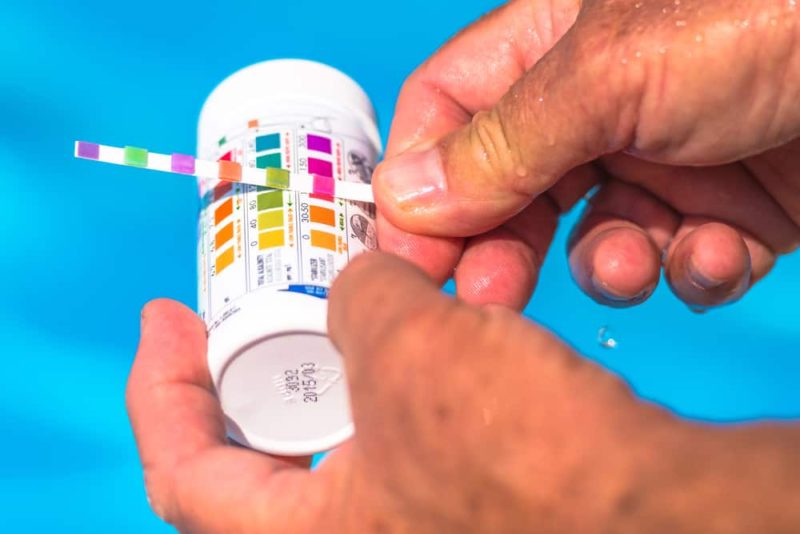There are many things you can do to prevent algae growth in your pond. There are also different ways you can get rid of existing algae.
It is not recommended to use pool algaecide in a pond; it isn’t designed to be safe for ponds. If used, you run the risk of depleting the oxygen supply in your pond and killing fish and plants. Preventative measures and pond dye will be most beneficial for algae control.
What should you do if you have an algae problem in your pond?
Using Pool Algaecide In A Pond
Pool algaecides are typically copper-based and use chemicals to disrupt the cell walls of algae. This chemical reaction oxidizes the water which can be harmful for fish and wildlife.
Pool algaecides usually work well with the combination of chlorine in your pool. Because ponds do not typically have chlorine, pool algaecide would not be as effective in a pond, even if pool algaecide didn’t have harmful chemicals in it.
Because of the copper-base, pool algaecides have a risk of staining your pool if you use too much of the product. Using this product in your pond could also stain rocks or concrete surfaces.
Pool algaecides are known to cause foaming in your pool. Foaming in a pond would be difficult to clear, would be harmful for plant and animal life, and would look bad.
Most producers of pool algaecides do not recommend using their products in ponds. Clorox Pool and Spa says to follow the label on their bottle:
“We do not recommend using this product for anything outside of label directions. Also, it would likely kill the fish. If you have any other questions or concerns, please give us a call at 1-800-SOS-POOL.”
Source
Overall, it is strongly suggested that you do not use pool algaecide to kill the algae in your pond. However, you can consider trying algaecides that are made for ponds, or try other methods to remove algae from your pond.
What is Algae and Algaecide?
There are three different kinds of algae: green, yellow, and black. There is also single celled algae plants that make your water turn a murky green color, often referred to as “pea soup” colored.
These algae are caused when the water has an abundance of sunlight. This plant really only needs sunlight to survive, and it can create the nutrients it needs by using light energy and carbon dioxide. It can produce asexually and can grow in less than ideal circumstances, making it harder to kill.
Algaecide uses extremely harsh chemicals, some of which are banned in certain states. These chemicals are highly effective at killing algae, but are also highly effective at killing other plants and living organisms.
The dead algae will fall to the bottom of your pond after the algaecide has taken effect. These dead algae need to be removed quickly, otherwise it will decay and release carbon dioxide. The carbon dioxide will then become fuel for new algae to grow and take their place, so it must be removed in order to prevent new algae growth.
When algae is killed rapidly, it takes in an abundance of oxygen, which causes a depletion of oxygen in the water. This rapid depletion is harmful to fish and plants. If you want to use algaecides, make sure to only use the correct amount; using too much will assuredly kill your fish. It is highly suggested that you increase circulation in your pond to try to replace the lost oxygen from the dying algae.
Other Methods for Killing Algae
A safer method for killing and preventing algae in ponds is to use a pond dye. Pond dyes block out sunlight, which diminishes the algae’s food source. Without enough energy from sunlight, the algae will not be able to grow and survive. Blue dye works well, but black dye works the best. The darker the water, the less sunlight, and the less sunlight, the less algae in your pond.
Pond filters are a good way to catch large pieces of algae in your pond. They can help to keep your water clear and clean, and help to promote a healthy ecosystem.
Another method to get rid of single-celled algae that aren’t caught by your pond filter is the UV light method. Larger chunks of algae can usually be caught by a normal pond filter, but if your pond has green, murky water, then you might want to try a UV light filter in addition to your normal filter. They are great for sterilizing your water, and killing off smaller organisms that would normally pollute your pond.
Pond algaecide instead of pool algaecide is another way you can remove algae from your pond. Pool algaecide isn’t designed to be safe for fish and plants, but pond algaecide is a safer alternative. However, it still uses harsh chemicals, and can still be harmful if too much is used or if it is used in the wrong way. When using any algaecides, proceed with caution.
Because algae requires sunlight to survive, you might want to consider adding tall trees to provide shade to your pond. The less light exposure there is, the better it will be for your pond in terms of algae prevention.
When getting rid of algae in a pond, there are many different methods you can try. Some methods are better than others, but you can see what works best for your pond. However, you should stay away from products that are not designed for ponds so that you do not harm your animals or plants.
